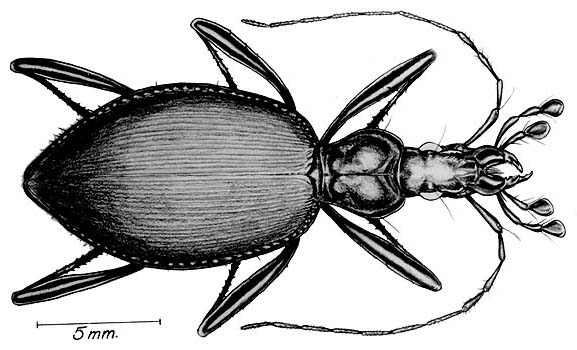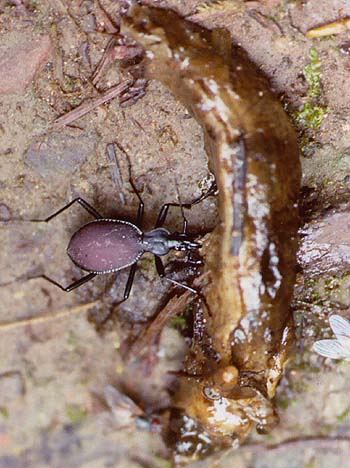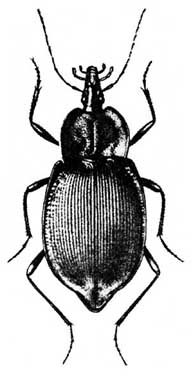
one of the eight charter members who founded Scarabs in 1937).
BUG OF THE MONTH: March 1997
Scaphinotus angusticollis
Order Coleoptera, Family Carabidae
Copyright © 1997 by Louise Kulzer
This article originally appeared in Scarabogram, March 1997, New Series No. 203, pp. 2-3.
Scaphinotus angusticollis is one of the more distinctive and attractive of the carabids, or ground beetles. It is common in forests, parks and gardens in our area. Once you learn to recognize it, it'll be love for life. For Scaphinotus has an appetite for escargot, and will indeed substitute the lowly slug when shelled delicacies are scarce!
 |
| Scaphinotus angusticollis (drawing by the late Dan Bonnell, one of the eight charter members who founded Scarabs in 1937). |
Scaphinotus angusticollis is large (satisfyingly so) and black, with a beauteous purple or greenish sheen in sunlight. The thorax is peculiarly shaped, turned up at the outer edges (a bit like a satellite dish), the legs are quite long and slender and the head is distinctly narrow and elongate. Truly the Afghan hound of the carabid world.
 |
| Scaphinotus scavenging a dead slug in the Columbia River Gorge © Louise Kulzer |
The narrow head is an adaptation to eating snails from the shell. Now there are shelled snails in forests around these parts, but with forest clearing and the introduction of non-native pests, shelled snails are less frequent and slugs abound. To be truthful, although I have seen Scaphinotus eat at slugs, I have never seen them eat the whole thing. Indeed, that could be a bit like trying to eat a whole elephant. And really, eating any part of a slug is just as good as eating the whole thing, don't you think, since it will surely die from the wound.
Scaphinotus is mainly nocturnal, but in Ballard we must have a renegade fringe population, for they are often active during the morning. Even well-behaved nocturnal Scaphinotus are probably often encountered while gardening, since they hide in leaf litter and under bark. S. angusticollis is described by Lindroth as a true woodland species, restricted to coastal forests from San Francisco to Kodiak, Alaska. Lindroth also reports that it climbs trees to a considerable height. Maybe it's after tree-climbing snails?
Like many ground beetles, Scaphinotus is flightless. In fact, the hind wings are practically nonexistent. You know what that means? It means it's worth making your garden Scaphinotus-friendly, since they are a better bet to stick around than lady-bug beetles. Remember, to grow your own, both the larval and adult forms must be happy. The larvae are grubs that live in the soil, preying on soil arthropods.
 |
| Scaphinotus elevatus (Europe) after Lindroth |
To do the trick, you could leave part of your back border in a semi-natural state. Downed logs are great, but lacking those, a small patch of trees or shrubs that generate a structurally complex duff (maple is my favorite) has good habitat potential. Encouraging forest mosses is good too (Scaphinotus are reported to hide under moss in woodland settings). A small pool made accessible to bugs is also a plus (but don't make it like a pitfall trap!). You may be rewarded by a handsome squad of anti-slug guard-beetles patrolling your garden by night.
Now, that'd make any gardener rest easy!
[Four Scaphinotus species occur in western Washington; one is limited to the Olympic mountains. S. angusticollis is the only one with a pronotum almost as narrow as the head. But none of our species has the pronotum nearly as broad as in the European species S. elevatus, shown at right. Hatch divides S. angusticollis into 4 subspecies, 2 in Oregon, 2 in Washington: the typical form in the Puget Sound area, and S. angusticollis olympiae in the Olympics, Willapa Hills, and along the coast. Our local subspecies has a reddish or purplish sheen on the elytra and a greenish sheen on the head and pronotum.]
References
Hatch, Melville H. 1953. The Beetles of the Pacific Northwest, Part I: Introduction and Adephaga. Seattle: University of Washington Press.
Lindroth, Carl. The Ground Beetles of Canada and Alaska. UW Allen Library call no. 595.705 OP, vols. 20, 24, 29, 33, 34, 35.
This page last updated 16 June, 2005